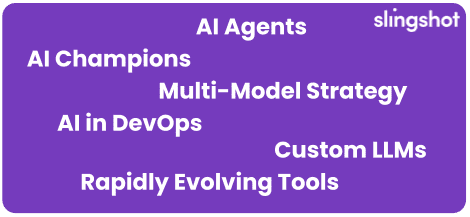Twelve months from now, today’s “cutting edge” might be the new normal or completely obsolete. In AI, the clock doesn’t just tick. It accelerates. For CIOs, that pace is both a challenge and an opportunity.
At Slingshot, we’ve lived this transformation firsthand. Tools we barely considered six months ago are now critical parts of our development workflows. We’ve already replaced others that once seemed promising. In this blog, we sat down with Chris Howard, CIO at Slingshot, to spotlight six AI trends on his radar and why they matter for any tech-savvy executive trying to stay ahead.
This blog isn’t a list of abstract buzzwords. These are practical, real-world shifts already reshaping how teams build, secure, and scale technology. And they are moving fast.
Summary
AI is accelerating, and CIOs need to move with it. Custom LLMs are becoming easier to implement. AI is reshaping DevOps through automation and modernization. Intelligent agents are starting to enhance workflows. Tools are evolving quickly, requiring constant reassessment. A multi-tool approach is now standard. Most importantly, the real advantage comes from people who explore, experiment, and drive adoption.
1. Custom LLMs Are Getting Easier and More Strategic
Adapting a large language model (LLM) to your business, by training it on your proprietary data and internal knowledge, is no longer out of reach.
“It’s easier and easier to embed custom large language model implementations in your organization,” Chris explains. “Using something like AWS Bedrock, you can create a secure, custom knowledge base with your organization’s data. That becomes more and more accessible and capable every week.”
This shift represents a turning point. Instead of relying on public models that may not understand your domain, CIOs can now pull from trusted base models and train them on their own content to create systems that speak their company’s language.
Why it matters:
Custom-trained LLMs open the door to smarter internal search, more intelligent agents, and entirely new workflows. For CIOs, this means enabling AI that is not just generative, but context-aware, secure, and aligned with business needs.
2. DevOps Is the Next Frontier for AI-Augmented Teams
Software development has been a proving ground for AI experimentation, but DevOps is quickly catching up. From code analysis to deployment automation, AI is shaping the entire lifecycle.
“In the last couple of months, things have really picked up,” says Chris. “AWS now has AWS Transform that can help you migrate your legacy mainframe or .NET app into more modern tech. That used to be a huge lift, expensive and slow. Now it’s way more accessible.”
He also pointed to OpenAI’s beta tool Aardvark, which continuously scans code for security vulnerabilities, and the rapid improvements in tools like Cursor and Claude Code, which are helping teams modernize faster and smarter.
Why it matters:
These tools can significantly reduce manual overhead while increasing software quality and velocity. For CIOs, it is a chance to upskill teams, modernize faster, and embed AI into the engineering process, not just at the surface, but deep in the stack.

3. AI Agents Are Moving From Concept to Practical Tool
While generative AI gets most of the headlines, autonomous agents are quietly becoming the real disruptors, especially in how workflows are designed and executed.
“Six months ago, we were playing with AI to build products. Now we’re starting to integrate agents,” says Chris. “I think the rest of this year and into early next year, we’ll be spending more time impacting workflows.”
He’s quick to note that agents still require oversight. “If I had a really important workflow, I don’t think I’d turn it loose with an agent just yet. But plugging them into parts of a process, where they can be helpful and are easy to monitor, that’s where we’re headed.”
Why it matters:
For CIOs, this trend is less about replacing jobs and more about strategically extending team capacity. With proper guardrails, agents can reduce repetitive work, improve response time, and assist in compliance-heavy tasks.
4. The Tools Are Changing Fast, Don’t Get Comfortable
At Slingshot, even internal AI tooling evolves almost monthly. What worked in July might no longer be your best option by December.
“Just when we were about to switch from Cursor 1.0 to something new, Cursor 2.0 dropped with better capabilities,” Chris recalls. “You almost have to continuously evaluate your tools to make sure your team is on the best ones.”
Six months ago, their developers were experimenting with Lovable and Bolt to build React apps. Now, Cursor, Claude Code, and Codex are in rotation, and Slingshot is exploring deeper integrations with agents and automation tools.
What changed? Not just the tech, but the teams themselves. “Our own developers and designers have evolved, too. They’ve built their own reusable prompts and figured out how to get predictable results. That human-AI pairing is where the real power is.”
Why it matters:
AI tools are not set-it-and-forget-it. CIOs need systems to evaluate what’s working regularly, sunset what isn’t, and adapt quickly. That might mean changing platforms or rethinking workflows entirely.
5. Multi-Tool Strategy Is the New Normal
A significant challenge Slingshot has embraced: no single AI tool is perfect for every part of the development lifecycle. Choosing the right one requires constant comparison, testing, and iteration.
“We’re constantly weighing tools like Claude Code and Cursor 2.0 for day-to-day coding,” says Chris. “For feature development and ideation, we might lean on ChatGPT. Each one brings something slightly different to the table.”
This hands-on experimentation is intentional. “Routinely experimenting with several tools gives your team the knowledge necessary to know when to adopt another,” Chris adds.
Why it matters:
For CIOs, a multi-tool strategy creates flexibility. It helps teams avoid stagnation, stay current, and build muscle memory around tool switching when the landscape shifts. You’re not just diversifying to cover your bases; you’re building organizational intuition about when change is worth it.
6. Your Biggest AI Advantage Isn’t a Platform, It’s People
Perhaps the most critical insight from this conversation: people matter more than platforms.
Chris puts it plainly: “The success we’ve had at Slingshot with AI has been because we identified a small cross-functional team of AI champions early. From product, UX, dev, QA, they met regularly, explored, experimented, and shared what they were learning.”
It’s not just about curiosity. It’s about structure. These champions weren’t just left to tinker. They were empowered to lead and to bring the rest of the company with them.
“You want people that see it as fun,” Chris adds. “Because honestly, it’s almost a full-time job just trying to keep up. Once you get comfortable, everything changes again.”
Why it matters:
CIOs don’t need everyone to be an AI expert, but they do need a few explorers: the ones who stay up late reading the docs, testing tools, and imagining what’s next.
Final Thought: The Timeline Is Compressed
The distance between “this might be useful someday” and “we’re deploying it next sprint” is shrinking fast.
“We’ve come a long way since the early Lovable and Bolt days,” says Chris. “That was only a few months ago.”
Looking ahead, the next wave (DevOps automation, agent orchestration, even on-device models) is already forming. But don’t wait for perfection. The pace of innovation means the best way forward is to start, learn quickly, and adapt in real time.

So, What’s Next?
For CIOs, the challenge isn’t whether to embrace AI. It’s how to do it intelligently, securely, and with just enough speed to stay ahead without falling behind.
If you’re just getting started, take a cue from Chris: “Identify the people in your organization who love this stuff. The ones that want to dig in, explore, and share. That might be the difference between success and failure.”
You don’t need to predict the future. You just need to build a team that’s ready for it.
Exploring AI? Don’t skip security.

Written by: Savannah Cherry
Savannah is our one-woman marketing department. She posts, writes, and creates all things Slingshot. While she may not be making software for you, she does have a minor in Computer Information Systems. We’d call her the opposite of a procrastinator: she can’t rest until all her work is done. She loves playing her switch and meal-prepping.

Expert: Chris Howard
Chris has been in the technology space for over 20 years, including being Slingshot’s CIO since 2017. He specializes in lean UX design, technology leadership, and new tech with a focus on AI. He’s currently involved in several AI-focused projects within Slingshot.
Frequently Asked Questions
Custom LLMs trained on your organization’s data are becoming easier to build and manage. They enable secure, context-aware AI capabilities like smarter internal search, more reliable automation, and systems that speak your business language.
AI is accelerating DevOps by automating tasks like code migration, vulnerability scanning, and deployment. Tools such as AWS Transform and Aardvark help teams modernize infrastructure faster while reducing manual effort and improving quality.
AI agents are systems that take action on behalf of users. They are starting to augment workflows in specific, controllable ways such as handling repetitive tasks, assisting with compliance, or improving turnaround time for routine processes.
Given the rapid evolution of AI tooling, CIOs should assess their stack monthly or quarterly. Staying current ensures your team uses the most capable, secure, and efficient tools, while avoiding stagnation or tool lock-in.
No single tool solves every problem. A multi-tool strategy ensures flexibility and resilience as technologies evolve. It builds team familiarity with diverse tools and helps organizations pivot quickly when better options emerge.
The most critical factor is not the tech, but the team. Cross-functional AI champions drive learning and adoption. Empowering curious, experimental thinkers helps organizations adapt faster and capture real business value from AI.




